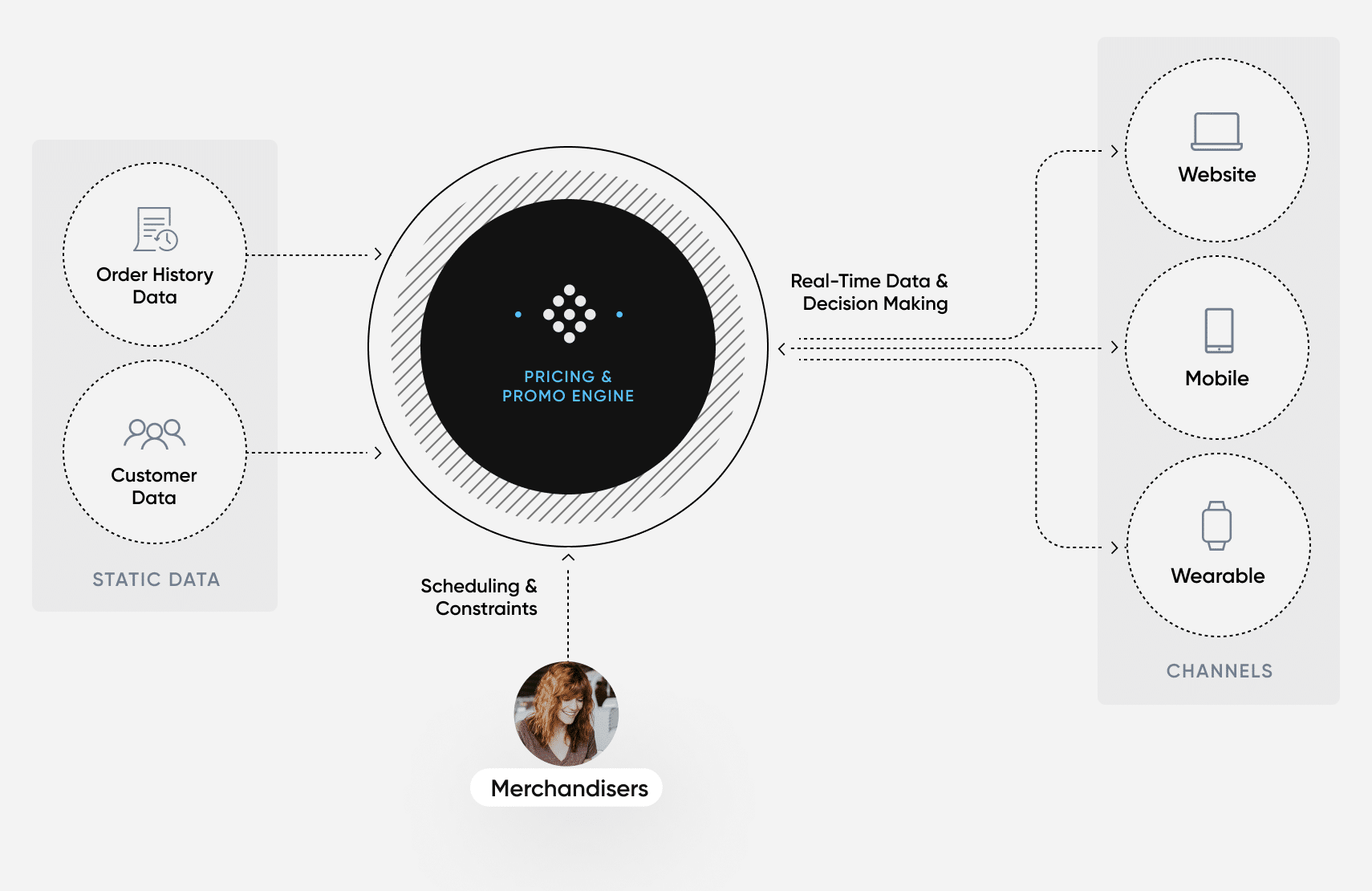What Is a Promotions Engine?

Promo engines allow retailers to maximize conversions by presenting highly targeted offers to users based on their unique characteristics.
With a promotions engine, you can easily set up a wide range of different promotions specifying the qualifying criteria and usage restrictions.
Promotions engines seamlessly integrate with other e-commerce solutions to ensure pricing and offers are accurately reflected across all sales channels.
fabric Offers leverages machine learning to present users specific offers based on their buying intent. You can organize all your promotions in a calendar view to efficiently manage campaigns at scale.
[toc-embed headline=”Promotions Engine Definition”]
Promotions Engine Definition
A promotions engine is a software solution for commerce designed to deliver personalized promotional offerings to shoppers based on their unique characteristics.

[toc-embed headline=”Overview of a Promotions Engine”]
Overview of a Promotions Engine
Today’s customers are less responsive to inconsistent pricing and non-personalized offers. To improve loyalty and boost sales, retailers need to tailor their pricing strategy for each customer interaction.
Promo engines use valuable data on products and buyer behavior to enable retailers to improve the customer experience by presenting the right offer at the right time.
There are two primary components the software uses to personalize the experience for each customer while optimizing results: price and promotions.
Price
Price may seem like a static element that is consistent across users and channels, however, adjusting prices based on buying intent and individual characteristics can lead to increased conversions.
Tiers such as base price and sales price are simple pricing variations retailers can use to increase engagement and sales. Retailers can also vary prices by dynamically adjusting them depending on location, user history, sales channel, or other variables.
Promotions
Promotions are special offers that allow customers to buy a product below its normal selling price. There are a wide variety of promotion types ranging from simple to complex. Like prices, promotions can be specified based on product type, sales channels, and other variables.
Here are some of the common types of offers used with promotions engines:
- Percentage discounts: a simple percentage discount applied on a product or order level basis
- Nominal discounts: a simple dollar discount applied on a product or order level basis
- Buy one get one: a product is offered for free whenever a customer buys a product to which the promotion applies
- Tiered promotions: a percentage or nominal discount that increases at different levels specified by the seller; for example, $10 off orders over $100 and $25 off orders over $200
Retailers can add complexity to offers by allowing customers to apply multiple promotions to the same order. For instance, a customer uses a 5% discount code on an order totaling $120 to reduce the price to $114 which will also qualify for a $10 off tiered promotion to reduce the price to $104.
[toc-embed headline=”How a Promotions Engine Works”]
How a Promotions Engine Works
A promo engine needs to seamlessly integrate with your e-commerce infrastructure to ensure your pricing strategy is reflected across all channels. It is also important that your promotion engine is able to pull valuable customer data from your CRM or other backend services to be able to create highly-personalized offers for each customer.
Efficiently planning a vast array of different promotions can be difficult for merchandisers to handle alone. Machine learning helps to alleviate this burden as AI can process data at a much faster rate than humans to be able to price products more accurately to maximize conversions.
This does not mean that manual input is not needed. Rather, business users and machine learning work in unison to optimize efficiency. This involves using machine learning for more detailed decisions like creating offers for specific customers while business users handle the constraints of the promotions. By having business users manage the constraints, promotions will be better aligned with the overall business objectives.
Some common usage restrictions present in promotion engines include:
- Restricting coupons to certain items, minimum order amounts, or maximum uses per customer
- Limiting promotions to highly segmented groups such as first-time visitors spending over a certain amount
- Only triggering offers after certain criteria are met such as location, purchase history, or cart content
Another critical component of promotion engines is timing. With a promotions engine, business users can schedule promotions in advance to automatically begin and end at a specified date. This includes being able to organize offers in a calendar view to efficiently manage present and future promotions.
[toc-embed headline=”Example of a Promotions Engine”]
Example of a Promotions Engine
fabric Offers is a good example of a promotions engine. It comes equipped with both pricing and promotions modules to fine-tune the offers presented to different users based on their buying intent.
You can run promotions on a specific segment of products by defining either an inclusion or exclusion list. Discounts can be applied as a percentage or nominal amount and you can create different tiers based on cart value or quantity of products.
fabric Offers provides a high level of control over your campaigns by allowing you to limit promotion usage based on user segment, individual use, and site-wide value.
Tech advocate and writer @ fabric.